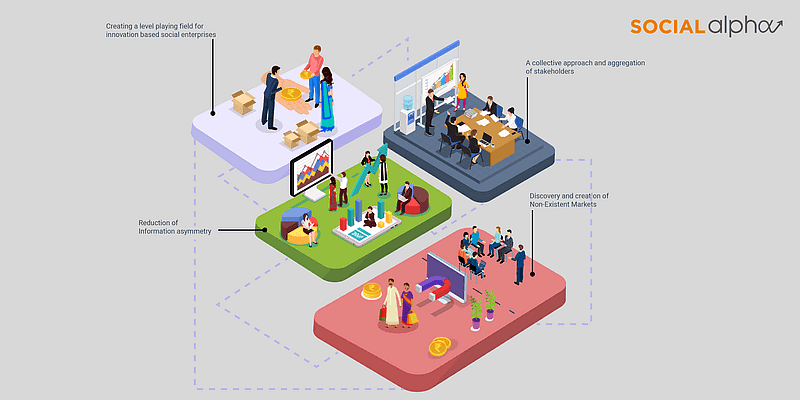Imagine this: A family of farmers in eastern UP, who have been growing maize and wheat on their meagre landholding using traditional farming practices, realise that their farm’s output has been on a steady decline. They contact the local Farmer Producer Organisation (FPO) seeking information on how to explore and deploy solutions for real-time soil testing and nutrient management. The FPO, aware of the fact that several farmers in the area are suffering from similar low-yield problems, reaches out to an online platform in the hope of an effective and affordable solution.
When the problem statement is onboarded on the digital platform, it draws the attention of an agricultural research institute in Kerala., which spots the synergies the problem statement has with the research it has been carrying out in various parts of the country. Once the agricultural scientists of the institution validate the problem, underscoring the need for urgent mitigation, a smart entrepreneur sees significant market potential in the pan-India problem and builds a solution. Along the way, the entrepreneur reaches out to potential collaborators across the agri-value chain for technical and financial resources and tests a successful pilot with the same FPO that brought the issue to the forefront.
This elegant process of problem-solving through crowd-sourcing is made possible because of that digital platform, which acted as a catalyst from the start to the finish. The Open Innovation Platform (OIP), a unique initiative by Social Alpha, is one such digital platform. It not only enables solution-creation but also builds a conducive ecosystem for a successful solution to reach the market, thus helping the entrepreneur further scale the product and deploy it across multiple geographies within India and outside.
What is an Open Innovation Platform?
OIP is a problem-centric platform that systematically identifies problems and manages the lab-to-market journey of innovative solutions that solve a set of validated problem statements. The platform would bring all possible stakeholders needed in this process, including the end user at the grassroot level, innovators, entrepreneurs, academicians and researchers, volunteers, development organisations/NGOs, philanthropic foundations, corporate CSR, incubators and the governments who are the primary decision-makers in this space. It is designed with algorithmic intelligence that drives pattern matching to understand the profile and transactions of each user and guide them towards collaboration and co-creation on the platform. OIP is built with the intention of creating a marketplace for problem statements, solutions and ecosystem players where the power of crowd-sourcing ensures a higher engagement rate and a faster turnaround time for solution development, discovery and deployment.
The platform is particularly relevant to the agri sector suffering from a fragmented approach where philanthropic and government resources have the potential to create manifold impact and need to be rationally utilised. Social Alpha has partnered with CISCO India CSR to launch Krishi Mangal, aimed at addressing the evangelisation of such a platform among other objectives. A common space like OIP fosters partnerships among stakeholders for optimal use of resources.
To aid this process, the OIP follows the below tenets:
- Open, seamless and easy access to problem statements, solutions in progress, catalogued solutions and enterprises that can be deployed. This allows multiple stakeholders to work together and create a brand-new solution or build on an existing solution, thus eliminating the scope for information asymmetry.
- Streamline processes for innovators and stakeholders to take innovations from the lab to the market.
- Curation, validation and prioritisation of problem sets, innovations and enterprises.
- Incubation for enterprise creation and commercialisation.
- Marketplace for investments as well as funding implementations.
Why OIP
Using science and cutting-edge technology to build innovative products and services has traditionally been undertaken by the R&D departments of industry houses as well as government research departments and organisations. However, in recent years, startups have been able to disrupt the status quo using agility, cost advantage and time to market. Since commercial incentives to shareholders determine the quantum of risk that corporations and startups are willing to take, innovators/entrepreneurs prefer to play it safe. They would want to cater to a familiar segment of society, which has the capability to pay for products and services that satisfy an unmet need or create a new need in itself!
This strategy leaves a vast majority of the population out of consideration because they are deemed poor and uneducated. These billions of people across the world are deprived of energy and healthcare solutions even as they grapple with low agriculture productivity, lack of access to market and affordable finance in their struggle to stay afloat. The problem becomes even more acute in the agri and its allied industries considering the remote geographies and the varying needs of each of them. While basic sciences have evolved to solve some of these challenges, they haven’t benefitted the non-consumptive segment of the population. It also shows that despite the best intentions of the government, academia and philanthropy, the innovation ecosystem dealing with social, economic and environmental challenges has failed to address a few fundamental gaps such as :
- Understanding the problem
- Empathising with the user or the customer
- Focus on access, affordability and user experience as core elements of the design
- Pilot with early adopters in an iterative approach
- A sustainable business model
The grassroots innovation ecosystem is a far cry from the structure to scale and integrated approach to innovation of corporates. To build a robust, resilient system, it needs to overcome challenges posed by
- Remote, inaccessible user affecting sales and distribution channels
- Information asymmetry leading to re-invention of wheel, limited reusability and sharing of best practices
- Users are sometimes not the customers – products/services paid for or subsidised by philanthropy, CSR or government subsidy policies are typically not in favour of incumbent startups leading to a barrier to enter the market
- Multiple stakeholders with different incentives in the value chain of innovation – academia, NGOs, government, startups, microentrepreneurs, commercial distributors/agents etc. And these stakeholders don’t collaborate quite naturally like in commercial use-cases.
Social Alpha aims to create an equitable ecosystem to foster discovery and collaboration through the OIP. On the one hand, it deploys philanthropic investments to build enterprises through its incubation and investment models, and on the other, its OIP is poised to reap the power of collective stakeholders by bringing innovators, entrepreneurs, governments and funders together for market-creating innovations.
We invite you to explore and partake in this larger vision of creating a collaborative platform to discover and address the long-standing problems that have been plaguing our sectors. Register today at www.agri.openinnovationplatform.org and work towards making a better India and the world.
The authors work with Social Alpha
Social Alpha is a multistage innovation curation and venture development platform for science and technology start-ups that address the most critical social, economic and environmental challenges through the power of entrepreneurship and market-creating innovations. Since its inception in 2016, Social Alpha has supported more 150 start-ups including 40+ seed investments. For more information, please visit www.socialalpha.org


![Read more about the article [Startup Bharat] This Indore-based SaaS startup is helping enterprises scale with conversational intelligence solutions](https://blog.digitalsevaa.com/wp-content/uploads/2022/02/genietalk-1645538996167-300x150.png)







